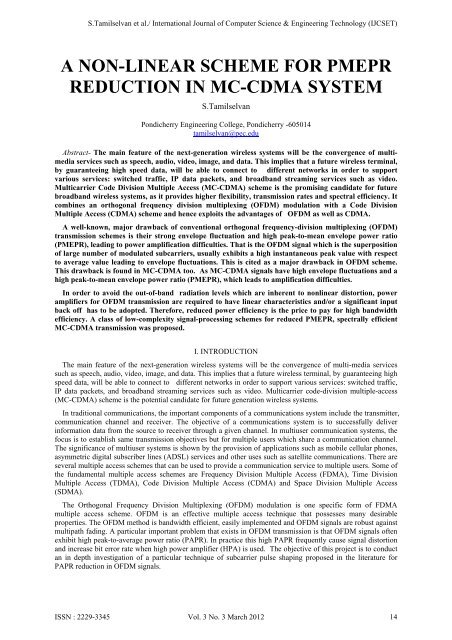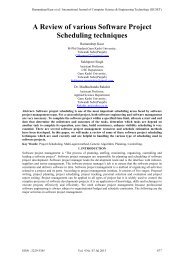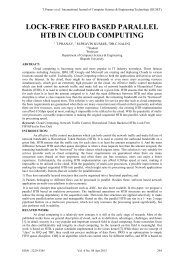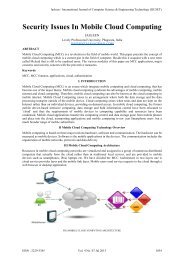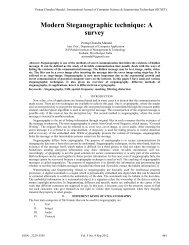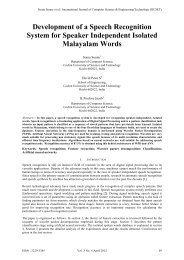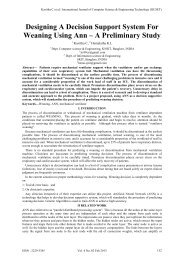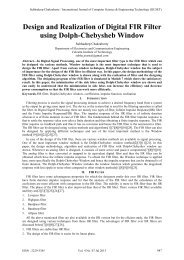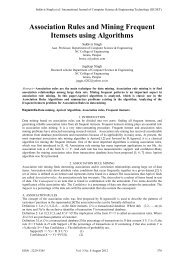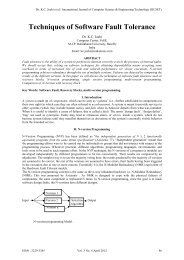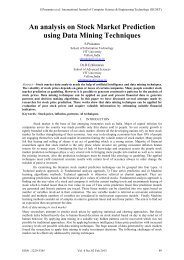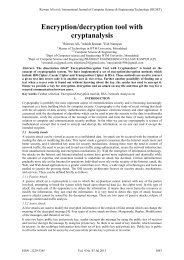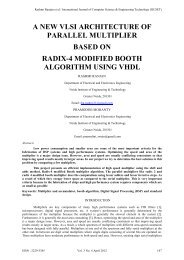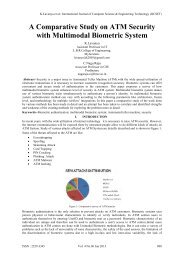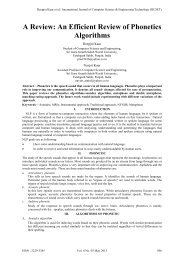a non-linear scheme for pmepr reduction in mc-cdma system - IJCSET
a non-linear scheme for pmepr reduction in mc-cdma system - IJCSET
a non-linear scheme for pmepr reduction in mc-cdma system - IJCSET
Create successful ePaper yourself
Turn your PDF publications into a flip-book with our unique Google optimized e-Paper software.
S.Tamilselvan et al./ International Journal of Computer Science & Eng<strong>in</strong>eer<strong>in</strong>g Technology (<strong>IJCSET</strong>)A NON-LINEAR SCHEME FOR PMEPRREDUCTION IN MC-CDMA SYSTEMS.TamilselvanPondicherry Eng<strong>in</strong>eer<strong>in</strong>g College, Pondicherry -605014tamilselvan@pec.eduAbstract- The ma<strong>in</strong> feature of the next-generation wireless <strong>system</strong>s will be the convergence of multimediaservices such as speech, audio, video, image, and data. This implies that a future wireless term<strong>in</strong>al,by guarantee<strong>in</strong>g high speed data, will be able to connect to different networks <strong>in</strong> order to supportvarious services: switched traffic, IP data packets, and broadband stream<strong>in</strong>g services such as video.Multicarrier Code Division Multiple Access (MC-CDMA) <strong>scheme</strong> is the promis<strong>in</strong>g candidate <strong>for</strong> futurebroadband wireless <strong>system</strong>s, as it provides higher flexibility, transmission rates and spectral efficiency. Itcomb<strong>in</strong>es an orthogonal frequency division multiplex<strong>in</strong>g (OFDM) modulation with a Code DivisionMultiple Access (CDMA) <strong>scheme</strong> and hence exploits the advantages of OFDM as well as CDMA.A well-known, major drawback of conventional orthogonal frequency-division multiplex<strong>in</strong>g (OFDM)transmission <strong>scheme</strong>s is their strong envelope fluctuation and high peak-to-mean envelope power ratio(PMEPR), lead<strong>in</strong>g to power amplification difficulties. That is the OFDM signal which is the superpositionof large number of modulated subcarriers, usually exhibits a high <strong>in</strong>stantaneous peak value with respectto average value lead<strong>in</strong>g to envelope fluctuations. This is cited as a major drawback <strong>in</strong> OFDM <strong>scheme</strong>.This drawback is found <strong>in</strong> MC-CDMA too. As MC-CDMA signals have high envelope fluctuations and ahigh peak-to-mean envelope power ratio (PMEPR), which leads to amplification difficulties.In order to avoid the out-of-band radiation levels which are <strong>in</strong>herent to <strong>non</strong><strong>l<strong>in</strong>ear</strong> distortion, poweramplifiers <strong>for</strong> OFDM transmission are required to have <strong>l<strong>in</strong>ear</strong> characteristics and/or a significant <strong>in</strong>putback off has to be adopted. There<strong>for</strong>e, reduced power efficiency is the price to pay <strong>for</strong> high bandwidthefficiency. A class of low-complexity signal-process<strong>in</strong>g <strong>scheme</strong>s <strong>for</strong> reduced PMEPR, spectrally efficientMC-CDMA transmission was proposed.I. INTRODUCTIONThe ma<strong>in</strong> feature of the next-generation wireless <strong>system</strong>s will be the convergence of multi-media servicessuch as speech, audio, video, image, and data. This implies that a future wireless term<strong>in</strong>al, by guarantee<strong>in</strong>g highspeed data, will be able to connect to different networks <strong>in</strong> order to support various services: switched traffic,IP data packets, and broadband stream<strong>in</strong>g services such as video. Multicarrier code-division multiple-access(MC-CDMA) <strong>scheme</strong> is the potential candidate <strong>for</strong> future generation wireless <strong>system</strong>s.In traditional communications, the important components of a communications <strong>system</strong> <strong>in</strong>clude the transmitter,communication channel and receiver. The objective of a communications <strong>system</strong> is to successfully deliver<strong>in</strong><strong>for</strong>mation data from the source to receiver through a given channel. In multiuser communication <strong>system</strong>s, thefocus is to establish same transmission objectives but <strong>for</strong> multiple users which share a communication channel.The significance of multiuser <strong>system</strong>s is shown by the provision of applications such as mobile cellular phones,asymmetric digital subscriber l<strong>in</strong>es (ADSL) services and other uses such as satellite communications. There areseveral multiple access <strong>scheme</strong>s that can be used to provide a communication service to multiple users. Some ofthe fundamental multiple access <strong>scheme</strong>s are Frequency Division Multiple Access (FDMA), Time DivisionMultiple Access (TDMA), Code Division Multiple Access (CDMA) and Space Division Multiple Access(SDMA).The Orthogonal Frequency Division Multiplex<strong>in</strong>g (OFDM) modulation is one specific <strong>for</strong>m of FDMAmultiple access <strong>scheme</strong>. OFDM is an effective multiple access technique that possesses many desirableproperties. The OFDM method is bandwidth efficient, easily implemented and OFDM signals are robust aga<strong>in</strong>stmultipath fad<strong>in</strong>g. A particular important problem that exists <strong>in</strong> OFDM transmission is that OFDM signals oftenexhibit high peak-to-average power ratio (PAPR). In practice this high PAPR frequently cause signal distortionand <strong>in</strong>crease bit error rate when high power amplifier (HPA) is used. The objective of this project is to conductan <strong>in</strong> depth <strong>in</strong>vestigation of a particular technique of subcarrier pulse shap<strong>in</strong>g proposed <strong>in</strong> the literature <strong>for</strong>PAPR <strong>reduction</strong> <strong>in</strong> OFDM signals.ISSN : 2229-3345 Vol. 3 No. 3 March 2012 14
S.Tamilselvan et al./ International Journal of Computer Science & Eng<strong>in</strong>eer<strong>in</strong>g Technology (<strong>IJCSET</strong>)• The zero padded frequency-doma<strong>in</strong> block { , k= 0,1,…N’-1}, where N’ is a powerof two, is <strong>for</strong>med byadd<strong>in</strong>g N-N’ zeros to the orig<strong>in</strong>al frequency-doma<strong>in</strong> blockis given Eqn.(1).As other multicarrier signals, MC-CDMA signals have high envelope fluctuations and a high peak-to-meanenvelopee power ratio (PMEPR), which leads to amplification difficulties. This is particularly important <strong>for</strong> theupl<strong>in</strong>k transmission, s<strong>in</strong>ce efficientlow-cost power amplification is desirable at the mobile term<strong>in</strong>als (MTs).Moreover, the transmission over time-dispersivechannels destroys the orthogonality between spread<strong>in</strong>g codes,which might lead to significant multiple-access <strong>in</strong>terference levels and frequent runn<strong>in</strong>g of HPA <strong>in</strong>to saturationregion reduces the power efficiency. To reduce the envelope fluctuations of the transmitted signals, whilema<strong>in</strong>ta<strong>in</strong><strong>in</strong>g the spectral efficiency, the MC-CDMA signal associated to each MT is submitted to a clipp<strong>in</strong>gdevice, followed by a frequency doma<strong>in</strong> filter<strong>in</strong>g operation. However, the<strong>non</strong><strong>l<strong>in</strong>ear</strong> distortion effects can behigh when an MC-CDMA transmitter with reduced envelope fluctuations is <strong>in</strong>tended.II. CHOICE OF PMEPR REDUCTION TECHNIQUEThere have been many proposal of methods <strong>in</strong>which the power ratio can be reducedd <strong>in</strong> MC-CDMA multi-ofcarrier signals. Some researchers have developedd methods of achiev<strong>in</strong>g lowPMEPR through the application“partial transmits sequence, block cod<strong>in</strong>g and selected mapp<strong>in</strong>g”. Other techniques oflower<strong>in</strong>g thePMEPRratio which have been published <strong>in</strong>volve complicated applications of supplementaryFFT function blocksrequir<strong>in</strong>gmore functional components. In addition, <strong>non</strong>-hardware basedapproaches that also <strong>in</strong>cur otherdisadvantages such as add<strong>in</strong>g <strong>in</strong><strong>for</strong>mation <strong>in</strong> overhead parameters or handshak<strong>in</strong>g algorithms to control PMEPRlevels. Additional <strong>in</strong><strong>for</strong>mation bear<strong>in</strong>g causes OFDM signal to be less bandwidth efficient.Though a class of low-complexity signal-process<strong>in</strong>g <strong>scheme</strong>s <strong>for</strong> reduced PMEPR, spectrally efficient MC-aCDMA transmission proposed requires supplementary FFTfunction blocks, but this <strong>scheme</strong> comb<strong>in</strong>es<strong>non</strong><strong>l<strong>in</strong>ear</strong>operation <strong>in</strong>the time doma<strong>in</strong> with a <strong>l<strong>in</strong>ear</strong>, filter<strong>in</strong>g operation <strong>in</strong> the frequency doma<strong>in</strong>. Thisfrequency-doma<strong>in</strong> filter<strong>in</strong>g, besidess not requir<strong>in</strong>g an <strong>in</strong>creased guard time to avoid <strong>in</strong>tersymbol <strong>in</strong>terference(ISI), canbe very selective, e.g., completely remov<strong>in</strong>g theout-of-band radiation effects of the preced<strong>in</strong>g<strong>non</strong><strong>l<strong>in</strong>ear</strong>operation.More recently, a similar class of signal-process<strong>in</strong>g <strong>scheme</strong>ss <strong>for</strong> the samegoals was analyzed. The differencelies <strong>in</strong> the type of <strong>non</strong><strong>l<strong>in</strong>ear</strong> operation with each class: a <strong>non</strong><strong>l<strong>in</strong>ear</strong>ity operat<strong>in</strong>g on thecomplex MC-CDMAsamples <strong>in</strong> [8], and a <strong>non</strong><strong>l<strong>in</strong>ear</strong>ity which separately operates ontheir real (I)and imag<strong>in</strong>ary (Q) parts <strong>in</strong>[9]. Our<strong>scheme</strong> considers the <strong>for</strong>mer class only, which provides better per<strong>for</strong>mance,and studies the cases where a given<strong>scheme</strong> (<strong>non</strong><strong>l<strong>in</strong>ear</strong> time-doma<strong>in</strong> operation followed by frequency-doma<strong>in</strong>filter<strong>in</strong>g) is repeatedly used, <strong>in</strong> aniterative way.Though the proposed method that is focused on does not require additional FFT’s operators and only requires<strong>in</strong>gle FFT and IFFT functions <strong>in</strong> the transceiverss to operate. The technique <strong>in</strong>volves the shap<strong>in</strong>g of time limitedsubcarrier pulses. Themodificationof subcarrier pulse shapes does not add extra <strong>in</strong><strong>for</strong>mation to the exist<strong>in</strong>gstructure of MC-CDMA signals and hence bandwidth efficiency is unaffected. Cod<strong>in</strong>gmethods as describedpreviously can assist <strong>in</strong>controll<strong>in</strong>g <strong>in</strong>terchannel <strong>in</strong>terference through channel cod<strong>in</strong>g.There<strong>for</strong>e, through the use of this<strong>non</strong>-<strong>l<strong>in</strong>ear</strong> signal process<strong>in</strong>g <strong>scheme</strong>, certa<strong>in</strong> pulse shape characteristics canbe tested<strong>in</strong> search <strong>for</strong> the best pulse characteristics. Theobjective is to f<strong>in</strong>d thegeneral pulse shapecharacteristics that promote the improvements <strong>in</strong> lower<strong>in</strong>g the factor of high PMEPRfound <strong>in</strong> MC-CDMAsignals.III. TRANSMISSION OF MC-CDMA SIGNALA WIDE CLASS OF NONLINEAR SIGNAL-PROCESSING SCHEMEWith the basic signal-process<strong>in</strong>g<strong>scheme</strong>s considered here <strong>for</strong> MC-CDMAtransmission is shown <strong>in</strong>Figure 1,each block of time-doma<strong>in</strong> samples is generated as follows.Figure 1 BlockDiagram <strong>for</strong> Proposed TechniqueeISSN : 2229-3345 Vol. 3 No. 3 March 2012 15
S.Tamilselvan et al./ International Journal of Computer Science & Eng<strong>in</strong>eer<strong>in</strong>g Technology (<strong>IJCSET</strong>) ; , ,… (1)• The Inverse Discrete Fourier Trans<strong>for</strong>m (IDFT) of this frequency-doma<strong>in</strong> block is computed, lead<strong>in</strong>g to thetime doma<strong>in</strong> block { ; n=0,1,...N-1} with is given Eqn.(2). ∑ (2) • Each sample is submitted to a <strong>non</strong><strong>l<strong>in</strong>ear</strong> operation(an envelope clipp<strong>in</strong>g)accord<strong>in</strong>g to, lead<strong>in</strong>g to themodified block { ; n=0,1,…,N’-1}, where is given Eqn.(3). | | (3)• A discrete Fourier trans<strong>for</strong>m (DFT) br<strong>in</strong>gs the <strong>non</strong><strong>l<strong>in</strong>ear</strong>ly modified block back to the frequency doma<strong>in</strong>,where a shap<strong>in</strong>g operation is per<strong>for</strong>med by a multiplier bank with selected coefficients, {Gk; k=0,1,…,N’-1}, so as to obta<strong>in</strong> the block , with is given by the Eqn.(4). ;,,…. (4)• The f<strong>in</strong>al frequency-doma<strong>in</strong> block results from by remov<strong>in</strong>g the zeros, where is shown <strong>in</strong>Eqn.(5). ;,,…….. (5)• Append<strong>in</strong>g zeros to each <strong>in</strong>put block prior to comput<strong>in</strong>g the required IDFT is a well-known OFDMimplementation technique, which is equivalent to oversampl<strong>in</strong>g, by a factor given <strong>in</strong> Eqn.(6) below, theideal MC-CDMA burst. (6)• The subsequent <strong>non</strong><strong>l<strong>in</strong>ear</strong> operation is crucial <strong>for</strong> reduc<strong>in</strong>g the envelope fluctuations, whereas the frequencydoma<strong>in</strong>filter<strong>in</strong>g us<strong>in</strong>g the set given <strong>in</strong> Eqn.(7) can reduce the result<strong>in</strong>g spectral spread<strong>in</strong>g (of course, withsome regrowth of the envelope fluctuations). ;,,,……, (7)The removal of subcarriers with zero amplitude reduces the computational ef<strong>for</strong>t and corresponds todecimation <strong>in</strong> the time doma<strong>in</strong>. For a given and a careful selection of , the <strong>non</strong><strong>l<strong>in</strong>ear</strong> characteristic (<strong>for</strong> a given<strong>in</strong>put level) and the set can {Gk} ensure small envelope fluctuations while ma<strong>in</strong>ta<strong>in</strong><strong>in</strong>g low out-of-bandradiation and <strong>in</strong>-band self-<strong>in</strong>terference levels. When the <strong>non</strong><strong>l<strong>in</strong>ear</strong> operation is chosen to be an ideal envelopeclipp<strong>in</strong>g, with clipp<strong>in</strong>g. , , (8)It should be mentioned that this wide class of signal-process<strong>in</strong>g <strong>scheme</strong>s <strong>in</strong>cludes, as specific cases, <strong>scheme</strong>sproposed so far. where the same clipp<strong>in</strong>g is adopted when assum<strong>in</strong>g ,the condition <strong>in</strong> Eqn.(8) with <strong>for</strong> the <strong>in</strong>bandsubcarriers, and out-of-band. It should also be mentioned that, <strong>for</strong> an ideal envelope clipp<strong>in</strong>g, the proposedsignal-process<strong>in</strong>g <strong>scheme</strong> can be shown to be equivalent to the peak cancellation method.A more sophisticated technique, allow<strong>in</strong>g improved PMEPR reduc<strong>in</strong>g results, could be simply developed onthe basis of the signal-process<strong>in</strong>g approach described above. Such a technique consists of repeatedly us<strong>in</strong>g, <strong>in</strong> aniterative way, the signal-process<strong>in</strong>g cha<strong>in</strong> which leads from to <strong>in</strong> Fig.1. The technique proposed <strong>in</strong> [17]corresponds to the particular case where the <strong>non</strong><strong>l<strong>in</strong>ear</strong> operation is an envelope clipp<strong>in</strong>g, and the frequencydoma<strong>in</strong>filter<strong>in</strong>g is characterized by <strong>for</strong> the Gk=0 <strong>for</strong> the out-of-band subcarriers.ISSN : 2229-3345 Vol. 3 No. 3 March 2012 16
S.Tamilselvan et al./ International Journal of Computer Science & Eng<strong>in</strong>eer<strong>in</strong>g Technology (<strong>IJCSET</strong>)A. Def<strong>in</strong>ition of PMEPRIV. RESULTS AND DISCUSSIONThe cont<strong>in</strong>uous time signal x(t) represents the sum of all the parallel transmission streams as expressed <strong>in</strong>Eqn.(9). Peak-to-mean envelope power ratio can clearly be recognised through the understand<strong>in</strong>g of the<strong>in</strong>dividual numerator and denom<strong>in</strong>ator expressions. The <strong>for</strong>mer specifies the maximum transmitted signalsquared value, which represents the peak power of the total transmitted MC-CDMA signal. The latter def<strong>in</strong>esthe average power across the sum of composite time doma<strong>in</strong> signals def<strong>in</strong>ed by x(t). The average transmittedsignal power can be found through the time average expectation of the entire signal power of the comb<strong>in</strong>ed Nsub-channels. |||| (9)A ratio is taken between the peak and the average power of the MC-CDMA signal to give a power ratio.PMEPR measurement of power ratio is derived from sampled discrete <strong>in</strong><strong>for</strong>mation <strong>in</strong> the signal <strong>in</strong><strong>for</strong>mation.B. Maximum PMEPR PlotThe particular equation of <strong>in</strong>terest is the maximum PMEPR equation def<strong>in</strong>ed <strong>in</strong> Eqn.(4), which specifies theworst case PMEPR. The def<strong>in</strong>ition of maximum PMEPR is entirely based on the summ<strong>in</strong>g of the pulse valuesthroughout the pulse <strong>in</strong>terval. The important factor that should be noted is that <strong>in</strong>creas<strong>in</strong>g pulse heights directlyaffects the maximum PMEPR.C. Cumulative Distribution FunctionThe occurrences of peak fluctuations seems to be follow<strong>in</strong>g CDF <strong>in</strong> a conventional MC-CDMA <strong>system</strong>. TheCDF of a probability distribution function evaluated at a number ‘x’, is the probability of the event occurrencesthat a Random Variable(X) with that distribution is less than or equal to ‘x’. The typical range of PMEPRvalues are shown <strong>in</strong> Figure 2.The behavior of the PMEPR is seen to decrease with <strong>in</strong>creas<strong>in</strong>g ‘n’ which reflects on the <strong>in</strong>creas<strong>in</strong>gcorrelation between subcarriers. The rate of decay <strong>in</strong> PMEPR plot is reduced as ‘n’ tend to a large value as thecurves approach a horizontal asymptote.For the normalised s<strong>in</strong>e pulse case, the plot of the maximum PMEPR aga<strong>in</strong>st the shape parameter ‘n’ <strong>in</strong> termsof CCDF <strong>for</strong> each iteration is illustrated <strong>in</strong> Figure 3.Figure 2 CDF plot of PMEPRISSN : 2229-3345 Vol. 3 No. 3 March 2012 17
S.Tamilselvan et al./ International Journal of Computer Science & Eng<strong>in</strong>eer<strong>in</strong>g Technology (<strong>IJCSET</strong>)TABLE 1COMLEMENTARY CUMULATIVE DISTRIBUTIONFUNCTIONNo. ofIterationPMEPR(dB)0 8.7550 20By plott<strong>in</strong>g the maximum PMEPR <strong>for</strong> a normalised s<strong>in</strong>e pulse, an attractive result was ga<strong>in</strong>ed. It can beobserved that the normalisation of s<strong>in</strong>e pulses have brought PMEPR levels lower than the unmodified s<strong>in</strong>epulse. The maximum PMEPR has changed considerably achiev<strong>in</strong>g a greater rate of PMEPR <strong>reduction</strong> per ‘n’.This implies that lower<strong>in</strong>g the energy of the pulses has direct impact on the lower<strong>in</strong>g of PMEPR.SNR(dB)1 7.5660 19.42 6.8031 17.43 4.8830 16.34 4.1113 15.9Figure 3 CCDF plots of each iterationAn OFDM modulation with N=64 subcarriers and an M-QAM constellation, with a Gray mapp<strong>in</strong>g rule, oneach subcarrier is considered. The set of multiply<strong>in</strong>g co efficient{Gk; k=0,1,2,…N’-1} has a trapezoidal shape,with Gk=1 <strong>for</strong> the N data subcarriers (<strong>in</strong>-band region), dropp<strong>in</strong>g <strong>l<strong>in</strong>ear</strong>ly to 0 along the first (N1-N)/2 out-ofbandsubcarriers at both sides of the <strong>in</strong>-band region, which means N1 <strong>non</strong>zero subcarriers. The <strong>non</strong><strong>l<strong>in</strong>ear</strong>operation is chosen to be an ideal envelope clipp<strong>in</strong>g .On consider<strong>in</strong>g the basic, s<strong>in</strong>gle-iteration signal-process<strong>in</strong>g <strong>scheme</strong>s, Figure 4 is concerned with thebandwidth-efficiency issues when us<strong>in</strong>g these <strong>scheme</strong>s, with a clipp<strong>in</strong>g level of 2.0. A well-known PSD-relatedfunction was adopted: the so-called fractional out-of-band power (FOBP), def<strong>in</strong>ed <strong>for</strong> a symmetrical PSD.Clearly, this clipp<strong>in</strong>g can lead to high out-of-band radiation levels.However, by us<strong>in</strong>g a frequency-doma<strong>in</strong> filter<strong>in</strong>g with Gk=1 <strong>for</strong> the data subcarriers and 0 <strong>for</strong> the rema<strong>in</strong><strong>in</strong>gones (i.e.) we can reduce these levels to those of conventional MC-CDMA. Further <strong>reduction</strong> is achieved if thisfilter<strong>in</strong>g is comb<strong>in</strong>ed with the w<strong>in</strong>dow<strong>in</strong>g procedure.ISSN : 2229-3345 Vol. 3 No. 3 March 2012 18
S.Tamilselvan et al./ International Journal of Computer Science & Eng<strong>in</strong>eer<strong>in</strong>g Technology (<strong>IJCSET</strong>)Figure 4 PMEPR Behaviour of each iterationThe transmitter employs a power amplifier which is quasi-<strong>l<strong>in</strong>ear</strong> with<strong>in</strong> the range of variations of the <strong>in</strong>putenvelope, and the coherent detection operates under perfect synchronization and channel estimation.On assum<strong>in</strong>g L iterations <strong>for</strong> two users and an envelope clipp<strong>in</strong>g level with 2.0 , while Gk=1<strong>for</strong> the <strong>in</strong>-bandsubcarriers and 0 <strong>for</strong> the rema<strong>in</strong><strong>in</strong>g From the Table 1, it is clear that the envelope fluctuations by us<strong>in</strong>g theiterative technique can be reduced. The maximum envelope can be already close to with just three or fouriterations.D. BER Per<strong>for</strong>manceFigure 5 Non-<strong>l<strong>in</strong>ear</strong>ity of HPAThe conventional BER per<strong>for</strong>mance of a MC-CDMA <strong>system</strong> without employ<strong>in</strong>g the an envelope clipp<strong>in</strong>g andfilter<strong>in</strong>g procedure <strong>in</strong> an iterative way is approximately as depicted <strong>in</strong> figure 6.Figure 6 Conventional BER of MC-CDMAISSN : 2229-3345 Vol. 3 No. 3 March 2012 19
S.Tamilselvan et al./ International Journal of Computer Science & Eng<strong>in</strong>eer<strong>in</strong>g Technology (<strong>IJCSET</strong>)Figure 7 BER per<strong>for</strong>mances of each iterationOn consider<strong>in</strong>g the correspond<strong>in</strong>g BER per<strong>for</strong>mances on an ideal additive white Gaussian noise (AWGN)channel, still with an envelope clipp<strong>in</strong>g as the <strong>non</strong><strong>l<strong>in</strong>ear</strong> operation. As expected, the required Eb/N0 decreaseswhen clipp<strong>in</strong>g level is <strong>in</strong>creased, and the BER per<strong>for</strong>mances with are already close to the correspond<strong>in</strong>gper<strong>for</strong>mances with <strong>in</strong>f<strong>in</strong>ite users. However, <strong>in</strong>creased values of subcarriers imply a higher PMEPR, i.e., an<strong>in</strong>creased power amplification backoff.Figure 6 shows the BER <strong>for</strong> each iteration <strong>in</strong> comparison with required/conventional BER per<strong>for</strong>mance. Theoptimum values of clipp<strong>in</strong>g level are 2.0 <strong>for</strong> 4, 2.6 <strong>for</strong> 16, and3.2 <strong>for</strong> 64QAM.Moreover, these optimum values of clipp<strong>in</strong>g levels are almost <strong>in</strong>dependent of the frequency-doma<strong>in</strong> filter<strong>in</strong>gef<strong>for</strong>t. When not consider<strong>in</strong>g the iterative procedure analyzed <strong>in</strong> chapter 3, where the signal-process<strong>in</strong>g cha<strong>in</strong> isrepeatedly used which leads from to peak amplitude clipped pulses, so as to provide an additional <strong>reduction</strong> ofthe envelope fluctuations while preserv<strong>in</strong>g a compact spectrum.From the Figure 7, the BER per<strong>for</strong>mance of MC-CDMA with this <strong>reduction</strong> technique reaches theconventional MC-CDMA per<strong>for</strong>mance of <strong>for</strong> <strong>in</strong>creased no. of iteration and degradation <strong>in</strong> SNR.V. CONCLUSIONS AND FUTURE RESEARCHIn this work, a problem experienced <strong>in</strong> the OFDM modulation technique <strong>in</strong> the MC-CDMA <strong>system</strong> has beenstudied. The various multiple access techniques that were common <strong>in</strong> modern communications <strong>system</strong>s are<strong>in</strong>troduced. OFDM modulation was <strong>in</strong>troduced which was a specific <strong>for</strong>m of multiple access technique based onFDMA and also discusses how OFDM modulation operates and commences the advantages and disadvantagesof the modulation <strong>scheme</strong>. The PAPR problem that is commonly experienced <strong>in</strong> MC-CDMA signals was<strong>in</strong>troduced provid<strong>in</strong>g the motivation <strong>for</strong> an effective solution.Consequently a wide class of digital signal-process<strong>in</strong>g <strong>scheme</strong>s <strong>for</strong> MC-CDMA transmission which comb<strong>in</strong>ea <strong>non</strong><strong>l<strong>in</strong>ear</strong> operation <strong>in</strong> the time doma<strong>in</strong>, and a <strong>l<strong>in</strong>ear</strong> filter<strong>in</strong>g operation <strong>in</strong> the frequency doma<strong>in</strong> was presentedand evaluated. The ultimate goal of these <strong>scheme</strong>s is to reduce substantially the envelope fluctuation of ord<strong>in</strong>aryMC-CDMA <strong>system</strong>, while keep<strong>in</strong>g its high spectral efficiency and allow<strong>in</strong>g a low-cost, power-efficientimplementation.A detailed evaluation of MC-CDMA signal transmission techniques which employ the signal-process<strong>in</strong>g<strong>scheme</strong>s considered here was carried out, <strong>in</strong>volv<strong>in</strong>g computations of power spectra, BER per<strong>for</strong>mances, andachieved PMEPR values. Such evaluation has taken advantage of our statistical characterization of thetransmitted blocks and <strong>in</strong>cluded other implementation issues (such as the impact of the time-w<strong>in</strong>dow<strong>in</strong>gprocedures). A set of per<strong>for</strong>mance results was presented and discussed, show<strong>in</strong>g that the proposed basic<strong>scheme</strong>s can provide a significant PMEPR <strong>reduction</strong> while keep<strong>in</strong>g a high spectral efficiency.The iterative technique based on the basic <strong>scheme</strong>s was shown to allow a further PMEPR <strong>reduction</strong>, alsoma<strong>in</strong>ta<strong>in</strong><strong>in</strong>g the spectral efficiency of conventional MC-CDMA, with only a moderately <strong>in</strong>creasedimplementation complexity. When compared with other distortionless techniques, also capable of reduc<strong>in</strong>g thePMEPR of MC-CDMA signals, these signal process<strong>in</strong>g techniques <strong>in</strong>volv<strong>in</strong>g deliberate <strong>non</strong><strong>l<strong>in</strong>ear</strong> distortionwere shown to offer improved per<strong>for</strong>mance/complexity tradeoffs, <strong>for</strong> small constellations and a high number ofsubcarriers.The <strong>non</strong>- <strong>l<strong>in</strong>ear</strong> signal process<strong>in</strong>g <strong>scheme</strong> has been used to test narrowband and broadband pulses conclud<strong>in</strong>gthat broadband pulses were far superior <strong>in</strong> reduc<strong>in</strong>g PMEPR. Numerical results demonstrate that improvementsISSN : 2229-3345 Vol. 3 No. 3 March 2012 20
S.Tamilselvan et al./ International Journal of Computer Science & Eng<strong>in</strong>eer<strong>in</strong>g Technology (<strong>IJCSET</strong>)<strong>in</strong> PMEPR <strong>reduction</strong> require certa<strong>in</strong> frequency characteristics of subcarriers pulses. Some of thesecharacteristics <strong>in</strong>clude:• Large ma<strong>in</strong> lobe width• Low sidelobe peaks• High or flat amplitude ma<strong>in</strong> lobe responsesThe worst case PMEPR values are obta<strong>in</strong>ed through the use of rectangular subcarrier pulses with highsidelobe peaks <strong>in</strong> their response. It is suggested that pulses with relatively low side lobe peaks should be used todeviate the worst case scenario. This is because the worst case PMEPR is obta<strong>in</strong>ed by us<strong>in</strong>g rectangular pulses.The <strong>non</strong>- <strong>l<strong>in</strong>ear</strong> signal process<strong>in</strong>g <strong>scheme</strong> proves to be a simple approach to PMEPR <strong>reduction</strong> based onmodifications to the exist<strong>in</strong>g MC-CDMA signal structure. Unlike techniques such as PTS and precod<strong>in</strong>g, <strong>non</strong><strong>l<strong>in</strong>ear</strong>signal process<strong>in</strong>g <strong>scheme</strong> does not require additional implementation complexity, modification <strong>in</strong> thereceiver structure or overhead cod<strong>in</strong>g at the expense of bandwidth respectively. The <strong>non</strong>- <strong>l<strong>in</strong>ear</strong> signalprocess<strong>in</strong>g <strong>scheme</strong> used <strong>in</strong> this thesis per<strong>for</strong>ms well <strong>in</strong> assist<strong>in</strong>g the study of efficient signal characteristics thatimprove PMEPR <strong>reduction</strong>.A typical <strong>scheme</strong> of signal process<strong>in</strong>g has been tested <strong>in</strong> this project. More optimized <strong>scheme</strong>s should betested <strong>in</strong> order to ga<strong>in</strong> a deeper understand<strong>in</strong>g of other signal characteristics and their effects on the per<strong>for</strong>manceof PMEPR <strong>reduction</strong>.VI. REFERENCES[1] L. Cim<strong>in</strong>i, Jr., “Analysis and simulation of a digital mobile channel us<strong>in</strong>g orthogonal frequency-division multiplex<strong>in</strong>g,” IEEETransaction Communication., vol. COM-33, pp. 665–675, July 1985.[2] A. Jones and T. Wilk<strong>in</strong>son, “Comb<strong>in</strong>ed cod<strong>in</strong>g <strong>for</strong> error control and <strong>in</strong>creased robustness to <strong>system</strong> <strong>non</strong><strong>l<strong>in</strong>ear</strong>ities <strong>in</strong> OFDM,”Proceed<strong>in</strong>gs of IEEE Vehicular Technology Conference., vol. 2, Atlanta, GA, May 1996, pp. 904–908.[3] S. Müller and J. Huber, “OFDM with reduced peak-to-average power ratio by optimum comb<strong>in</strong>ation of partial transmitsequences,” Electronics Letters, vol. 33, no. 5, pp. 368–369, Feb. 1997.[4] S. Müller, R. Bäuml, R. Fischer, and J. Huber, “OFDM with reduced peak-to-average power ratio by multiple signalrepresentation,”Annual Telecommunication, vol. 52, pp. 58–67, Feb. 1997.[5] L. Cim<strong>in</strong>i, Jr. and N. Sollenberger, “Peak-to-average power <strong>reduction</strong> of an OFDM signal us<strong>in</strong>g partial transmit sequences,”IEEE Communication Letters, vol. 4, pp. 86–88, Mar. 2000.[6] R. O’Neill and L. Lopes, “Envelope variations and spectral splatter <strong>in</strong> clipped multicarrier signals,” Proceed<strong>in</strong>gs of IEEEPersonal, Indoor, Mobile Radio Conference., vol. 1, Sept. 1995, pp. 71–75.[7] X. Li and L. J. Cim<strong>in</strong>i, Jr., “Effects of clipp<strong>in</strong>g and filter<strong>in</strong>g on the per<strong>for</strong>mance of OFDM,” IEEE Communication Letters, vol.2, pp. 131–133, May 1998.[8] R. D<strong>in</strong>is and A. Gusmão, “A class of signal process<strong>in</strong>g algorithms <strong>for</strong> good power/bandwidth tradeoffs with OFDMtransmission,” Proceed<strong>in</strong>gs of IEEE International Symposium In<strong>for</strong>mation Theory, June 2000, pp. 216–216.[9] “A new class of signal process<strong>in</strong>g <strong>scheme</strong>s <strong>for</strong> bandwidth-efficient OFDM transmission with low envelope fluctuation,”Proceed<strong>in</strong>gs of IEEE Vehicular Technology Conference, vol. 1, pp. 658–662, May 2001.[10] H. Rowe, “Memory less <strong>non</strong><strong>l<strong>in</strong>ear</strong>ities with Gaussian <strong>in</strong>put: Elementary results,” Bell Syst. Tech. Journal, vol. 61, pp. 1519–1525, Sept. 1982.[11] H. Ochiai and H. Imai, “Per<strong>for</strong>mance of deliberate clipp<strong>in</strong>g with adaptive symbol selection <strong>for</strong> strictly bandlimited OFDM<strong>system</strong>s,” IEEE Journal on Selected of Areas Communication, vol. 18, pp. 2270–2277, Nov. 2000.[12] J. Armstrong, “New OFDM peak-to-average power <strong>reduction</strong> <strong>scheme</strong>,” Proceed<strong>in</strong>gs of IEEE Vehicular Technology Conference,vol. 1, pp. 756–760 May 2001.[13] H. Ochiai and H. Imai, “Per<strong>for</strong>mance analysis of deliberately clipped OFDM signals,” IEEE Transaction Communication, vol.50, pp. 89–101, Jan. 2002.[14] R. D<strong>in</strong>is and A. Gusmão, “Per<strong>for</strong>mance evaluation of an iterative PMEPR-reduc<strong>in</strong>g technique <strong>for</strong> OFDM transmission,”Proceed<strong>in</strong>gs of IEEE GLOBECOM, vol. 1, pp. 20–2, Dec. 2003[15] R. Nee and R. Prasad, OFDM <strong>for</strong> Wireless Multimedia Communications. Norwood, MA: Artech House, 2000.[16] T. May and H. Rohl<strong>in</strong>g, “Reduc<strong>in</strong>g the peak-to-average power ratio <strong>in</strong> OFDM radio transmission <strong>system</strong>s,” Proceed<strong>in</strong>gs of IEEEVehicular Technology Conference, vol. 3, pp. 2474–2478 ,May 1998.[17] J. Armstrong, “Peak-to-average power <strong>reduction</strong> <strong>for</strong> OFDM by repeated clipp<strong>in</strong>g and frequency-doma<strong>in</strong> filter<strong>in</strong>g,” IEEEElectronics Letters, vol. 38, no. 5, pp. 246–247, Feb. 2002.[18] R. D<strong>in</strong>is and A. Gusmão, “On the per<strong>for</strong>mance evaluation of OFDM transmission us<strong>in</strong>g clipp<strong>in</strong>g techniques, ”Proceed<strong>in</strong>gs ofIEEE Vehicular Technology Conference, vol. 5, pp. 2923–2928, Sept. 1999.[19] G. Stette, “Calculation of <strong>in</strong>termodulation from a s<strong>in</strong>gle carrier amplitude characteristic,” IEEE Transaction Communication.,vol. COM-22, pp. 319–323, Mar. 1974.[20] M. Abramowitz and I. Stegun, Handbook of Mathematical Functions. New York: Dover, 1972.ISSN : 2229-3345 Vol. 3 No. 3 March 2012 21


